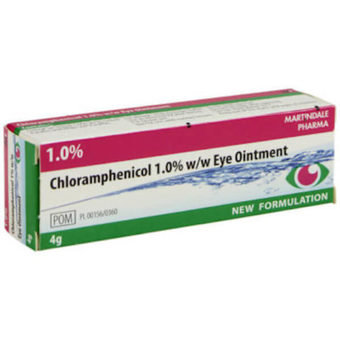Medication features
Chloramphenicol 1% Eye Ointment treats simple eye infections that cause grittiness and redness (acute bacterial conjunctivitis). The conjunctiva is a translucent membrane that coats the inner surface of your eyelid and the white section of your eye. This antibiotic eye ointment is suitable for adults and children aged two years and over. The active ingredient (Chloramphenicol) is a broad-spectrum antibiotic that targets bacterial conjunctivitis caused by chloramphenicol-susceptible organisms.
- Fast, effective relief for bacterial conjunctivitis
- Pharmacy strength eye ointment
- Next Day Delivery Available
Overview
What Is Chloramphenicol?
Chloramphenicol is an antibiotic eye ointment that eliminates the bacteria which cause eye infections such as conjunctivitis.
Each gram of chloramphenicol eye ointment contains 10 milligrams of chloramphenicol, the active ingredient. Chloramphenicol is prescribed to both children and adults.
Chloramphenicol Ointment Uses
Chloramphenicol eye ointment is used to treat bacterial eye infections like conjunctivitis in adults and children aged 2 and over. It can sometimes be prescribed to treat ear infections.
Conjunctivitis is a common condition that is caused by bacteria in the eyes. By quickly eliminating the bacteria which cause eye infections such as conjunctivitis, chloramphenicol soothes symptoms such as redness, itchiness and inflammation. Chloramphenicol is not effective in treating eye infections caused by a virus (viral eye infections).
You may not be able to use chloramphenicol if you have had an allergic reaction to chloramphenicol or another medicine in the past; or if you or a family member have ever had aplastic anaemia, a rare condition characterised by the bone marrow not producing enough blood cells.
How Does Chloramphenicol Work?
Chloramphenicol – the active ingredient in chloramphenicol eye ointment - is an antibiotic that works by stopping the growth of different types of bacteria. By inhibiting bacterial protein synthesis, chloramphenicol prevents bacteria from multiplying. The immune system will then eliminate the bacteria that remain.
Chloramphenicol in Pregnancy
Chloramphenicol eye ointment can be used in pregnancy, as the amounts that are absorbed into the bloodstream are too small to harm your baby. It is not thought that chloramphenicol affects fertility in women or men.
You can usually use chloramphenicol while you are breastfeeding, as long as your baby is healthy. The amount of chloramphenicol that passes into the breastmilk isn’t known, but it is thought to be a small amount. As research in this area is limited, if you are breastfeeding, you may be advised to use other medicines until more studies are carried out. Breastfeeding mothers should speak to their doctor or pharmacist before using the ointment.
You should always wash your hands thoroughly after using chloramphenicol eye treatment, particularly before you pick up your baby. If your baby seems unsettled, develops a rash, appears an unusual colour or has a stomach upset, seek medical advice as soon as possible.
Tobramycin vs Chloramphenicol
Like chloramphenicol, tobramycin is an antibiotic that is used to treat eye infections. Chloramphenicol and tobramycin are both prescribed to treat bacterial conjunctivitis and work in a similar way to kill the bacteria that causes the condition. The two medicines are both eye ointments and are applied every few hours. Unlike chloramphenicol, tobramycin is not recommended to treat ear infections.
A significant point of difference is that while chloramphenicol is a broad-spectrum antibiotic that is effective against both gram-positive and gram-negative bacteria (two types of bacteria with different structures), tobramycin is an aminoglycoside antibiotic that is more effective against gram-negative bacteria.
Ofloxacin vs Chloramphenicol
Chloramphenicol and ofloxacin are both antibiotics which are used to treat bacterial eye infections such as conjunctivitis. Ofloxacin is also used to treat corneal ulcers and is a more common treatment than chloramphenicol for the condition.
The two medicines have similar doses and are applied in the same way, being dropped into the gap between the eye and the eyelid. However, ofloxacin and chloramphenicol have different mechanisms of action. Ofloxacin is a quinoline antibiotic that works by blocking the bacteria that cause eye infections, obstructing the chemicals that the bacteria need for repair and reproduction. On the other hand, chloramphenicol is a broad-spectrum antibiotic that works in a different way to kill bacteria, inhibiting protein synthesis and preventing the growth and multiplication of bacteria.
Research has shown that both ofloxacin and chloramphenicol eye ointment are highly effective in treating bacterial ocular (eye) infections. The study concluded: “Ofloxacin performed as well as chloramphenicol in promoting microbiological, clinical, and overall improvement in patients with bacterial eye infections.”
Chloramphenicol Reviews
Users online have indicated that chloramphenicol was effective in treating symptoms of their bacterial eye infection, such as conjunctivitis (also known as ‘pink eye’). The treatment is observed by users to ease inflammation and itchiness, noticeably soothing symptoms within just two days.
Among the commonly reported side effects are a burning or stinging sensation after the application of the ointment, and temporary blurred vision.
Can You Buy Chloramphenicol Over the Counter in the UK?
In the UK, you can purchase chloramphenicol eye ointment over the counter, and also be prescribed the medicine by a doctor. You can purchase chloramphenicol online or from your local pharmacy.
Why not buy chloramphenicol eye ointment online at Cloud Pharmacy? It’s quick and convenient. After your chloramphenicol is dispensed, we will send it via our next-day delivery service.
Directions
How Long Does Chloramphenicol Take To Work?
The majority of people will experience an improvement in their bacterial eye condition within two days of starting to use chloramphenicol eye ointment. If you are taking chloramphenicol for an ear infection, it may take a few days before you feel better.
Chloramphenicol ointment is usually used for one week. Even if your symptoms subside and your eye appears normal, you should continue to take chloramphenicol for at least another 48 hours. Don’t use the ointment for longer than a week unless instructed to do so by your doctor. The maximum duration of treatment with chloramphenicol is 10-14 days.
If you’ve been using chloramphenicol for a few days and don’t feel better, or your symptoms worsen, tell your doctor or pharmacist.
How to Use Chloramphenicol Eye Ointment
The dosage for 0.5% chloramphenicol eye ointment to treat conjunctivitis is as follows:
- For the first 2 days – one drop into each affected eye every two hours during your waking hours.
- For the next 3 days – one drop into each affected eye every four hours during your waking hours.
Your doctor may advise a different dosage, depending on what you are using chloramphenicol eye ointment for.
Always wash your hands before using chloramphenicol eye ointment, to prevent spreading the infection to another eye or ear. Before applying the treatment, use a finger to gently pull down your lower eyelid while tilting back your head. Then, holding the tube so that the nozzle is close to your eye, squeeze around 1 cm of ointment in the gap between your eye and your lower eyelid. After the ointment has been applied, close your eyes for two minutes.
You should keep the cap of your chloramphenicol eye ointment closed when you are not using it. Don’t touch the nozzle with your fingers, or allow the nozzle to touch your eye, ear, or skin. You might find that a mirror helps you to apply the ointment, allowing you to see where your eye and eyelid are in relation to the nozzle before application. Once you’ve finished your course of chloramphenicol, throw away any ointment that is left over.
If you forget to apply your chloramphenicol ointment – have your dose as soon as you remember, then use it again at the usual time. If remembering your applications is tricky, you could set an alarm to remind you of your application times.
If you apply too much chloramphenicol – don't worry. You shouldn’t suffer any adverse effects if you use more ointment than intended by mistake.
Side Effects
Chloramphenicol Side Effects
Not everyone will experience side effects from chloramphenicol eye ointment. Among the most common potential side effects of chloramphenicol, which occur in over one in 100 people, are:
- A burning or stinging sensation in the eye after application
- An irritated eye
These side effects typically happen just after you have applied the ointment, and do not last long. Avoid rubbing your eye during this time, as this may irritate your eye further. Putting a cold wet flannel over your eye for a few minutes can help to soothe these common side effects.
Serious side effects from chloramphenicol are rare, occurring in less than one in 1,000 people. If you experience any of the following side effects contact a medical professional or call 999:
- Easily bruising
- Feeling unusually weak
- Feeling unusually tired
- Getting infections more easily
You should also seek immediate medical help if you experience any signs of a serious allergic reaction, such as:
- Wheezing
- A skin rash
- Tightness in the chest
- Tightness in the throat
- Breathing or talking difficulty
- Swelling of your face, tongue or throat
Patient Information Leaflet
Chloramphenicol Eye Ointment Patient Information Leaflet
For more information on chloramphenicol medication, take a look at the Patient Information Leaflet below:
Chloramphenicol 1% Eye Ointment Reviews
Confirm Chloramphenicol 1% Eye Ointment treatment selection
| 0.3mg | 4g Tube | £7.99 |

















